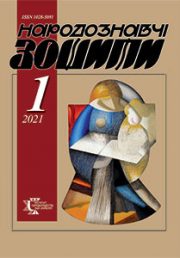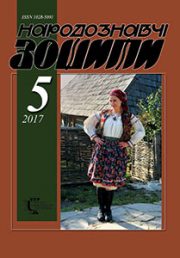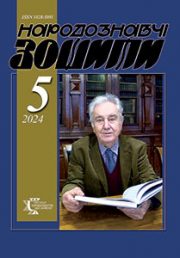The Ethnology Notebooks. 2022. № 2 (164), 401—416
UDK 398.81(477.83-2):[94:329.17(477)”19″]
DOI https://doi.org/10.15407/nz2022.02.401
KRAVTSOVA Galina
- ORCID ID: https://orcid.org/0000-0002-3774-1481
- Candidate of Philology,
- the Institute of Ethnology of the National Academy
- of Sciences of Ukraine,
- Research folklore department,
- 15, Svobody ave., 79000, Lviv, Ukraine,
- Contacts: e-mail: galynamagas@gmail.com
Abstract. During the Second World War and after the so-called «great victory», the communist totalitarian regime pursued a policy of terror in Ukraine and, in particular, in Galicia, through the relevant repressive authorities. As a result, millions of Ukrainians have been persecuted, deprived of life, liberty, property, tortured, deported, sent to special settlements outside Ukraine, forced labor in conditions of restriction of liberty, deprived of citizenship or otherwise degraded in their civil rights and freedoms. A large number of people were forced to flee, hide, live in unsatisfactory conditions, separate from their relatives and friends, and give their children upbringing to other people.
Folk prose about the life of the Galicia civilian population during and after World War II includes several major cycles. Key topics addressed in the proposed article: cooperation with the underground and mass deportations. Such texts record examples of assistance to the underground, local manifestations and results of the civilians struggle against the occupiers, testify to the role of popular support for the UPA, the place and importance of the OUN and UPA sympathizers in the national-liberation struggle of the mid-twentieth century. In addition, they reflect the issue of returning deportees home, all the difficulties that arose in connection with the branding of «UPA accomplice». Such stories and legends have not been the subject of extensive research in folklore yet. Therefore, their folklore elaboration is relevant today. In the proposed exploration, the autho r aims to find out the peculiarity of the relevant prose samples recorded in the Stryi district, primarily — their poetic system. The object of research is the texts of stories and legends, the subject — their structure and poetics. The main attention is paid to the motives and folklore constants, which are typical for the texts of oral folk art, they are the focus. The basis of the work is the author’s field materials.
Keywords: folk prose, poetics, motive, deportations.
Received 9.05.2022
REFERENCES
- Khalyuk, L. (2013). Oral folk tales of Ukrainian immigrants of Lemkivshchyna, Kholmshchyna, Pidlyashshya ta Nadsyannya: genre-thematic specifics, artistic features. Kyiv [in Ukrainian].
- Vakhnina, L. (2011). Folklore of ukrainians in Poland (the phenomenon of Northern Pidlyashshya). Kyiv Polonistic Studies (Vol. XVIII, pp. 508—511). Kyiv [in Ukrainian].
- Kyrchiv, R. (2002). Folklore study of Kholmshchyna and Pidlyashshya. From folklore regions of Ukraine. Essays and articles (Pp. 263—294). Lviv [in Ukrainian].
- Kuzmenko, O. (2010). The Motherland concept in the paradigm of artistic images of space in folklore innovations about eviction (on the basis of own records from the Western Boykivshchyna). Literature. Folklore. Problems of poetics (Issue 34, pp. 210—220). Kyiv [in Ukrainian].
- Pavliv, Yu. (2015). The image of the «small homeland» in the historical memory of immigrants from Kholmshchyna and Lemkivshchyna. Ukraine-Poland: historical heritage and public consciousness (Vol. 8, pp. 163—179). Lviv [in Ukrainian].
- Kachmar, M. (2020). Deportation of Ukrainians from Zakerzonnya in 1944—1945: before and after (on the materials of the Tulyholove village, Gorodetsky district, Lviv region). Ethnographic notebooks, 3, 573—584 [in Ukrainian].
- Chikalo, O. (2013). Songs-chronicles of the XX century: folklore chronicle of arrests and deportations. Ethnographic notebooks, 1, 40—44 [in Ukrainian].
- Kravtsova, G. (2019). Songs-chronicles of the period of national liberation struggles in the XX century: themes, motives, images (on the materials collected in the Stryi district). Ethnographic notebooks, 5, 1191—1199. Lviv [in Ukrainian].
- On the repression victims rehabilitation of the communist totalitarian regime of 1917—1991. Retrieved from: zakon.rada.gov.ua/laws/show/962-12#n105 [in Ukrainian].
- Slyvka, Yu. (Ed.). (1996). Origins and consequences of the national tragedy. Deportations. Western lands of Ukraine in the late 30’s — early 50s. Documents, materials, memoirs (Vol. 1, pp. 5—26) [in Ukrainian].
- Bazhan, O., Stasiuk, O., & Pershina, T. Deportation. ESU. Retrieved from: https://esu.com.ua/search_articles.php?id=26038 [in Ukrainian].
- Lunyo, E. (Ed.). (2015). Insurgent heroic epic and current issues of modern state formation. Yavoriv region in the insurgent struggle. Stories of participants and eyewitnesses (Vol. 2, pp. 3—20) [in Ukrainian].
- Ginda, O. (2015). The «mother» concept in labor songs and poetry of family issues. Poetic creativity of the Ukrainian labor community in Italy at the beginning of the XXI century in the context of folk tradition (Pp. 231—254) [in Ukrainian].
- Kuzmenko, O. (2018). Dramatic Human Existence in Ukranian Folklore: Conceptual Forms of Expression (the Pperiod of WWI and WWII). Lviv [in Ukrainian].
- Kuzmenko, O. (2018). Folklore signs of military existence in the triad of concepts «will» — «slavery» — «fate». Ethnographic notebooks, 1, 125—137 [in Ukrainian].
- Chikalo, O. (2020). The national hero in the folklore narratives of the mid-twentieth century: semantic and poetic aspects. Totalitarianism as a system of national memory destruction: a collection of scientific papers on the materials of the All-Ukrainian scientific-practical conference (Pp. 161—166) [in Ukrainian].
- Mushketyk, L. (2014). Characters of the Ukrainian folk tale. Kyiv [in Ukrainian].
- Koval, G. (2014). Color as a sign of formation in calendar-ritual poetry. Ethnographic notebooks, 4, 733—740 [in Ukrainian].
- Lunyo, E. (2012). The cult of the native army in the insurgent epic tradition of Yavoriv region. Ethnographic notebooks, 5, 890—907 [in Ukrainian].
- Koval-Fuchylo I. (2021). The motive of the lost paradise in stories about forced resettlement. Folkart and ethnology, 2, 87—97 [in Ukrainian].
- Zhayvoronok, V. (2006) Signs of Ukrainian ethnoculture: Dictionary-reference book. Kyiv [in Ukrainian].
- Moiseiv, I. (1993). Native house — a category of Ukrainian spirituality. Modernity, 7, 130—146 [in Ukrainian].
- Livinska, O. (2004). It is not too late for midnight at home, or an archetype in Ukrainian fiction. Multiversum. Philosophical Almanac, 44. Kyiv: Center for Spiritual Culture. Retrieved from: http://www.filosof.com.ua/Jornel / M_44 /Livinska.htm [in Ukrainian].
- Veronska, T. People from whom Ukraine was to be evicted. Local History. Retrieved from: https://localhistory.org.ua/texts/statti/liudi-z-iakikh-mali-viseliti-ukrayinu/ [in Ukrainian].
- Sokil, V. (2017). Folklore prose about the famines of the XX century in Ukraine. Lviv [in Ukrainian].
- Lunyo, E. (2005). Yavorivshchyna in the insurgent struggle: Stories of participants and eyewitnesses (Vol. 1): Nakonechne Pershe. Finally the Second [in Ukrainian].
- Demyan, G. (2003). Ukrainian insurgent songs of 1940—2000: historian-folklorist. Research. Kyiv: Ukrainian Publishing Union; Lviv: Halytska vydavnycha spilka [in Ukrainian].
- Golubets, O. (2019). I fled from Germany, but did not escape from Siberia (stories-memoirs of Anna Urbanovych, a native of Kosamach Kosiv district of Ivano-Frankivsk region. National Memory (in honor of the victims of totalitarianism (Issue III, pp. 21—27) [in Ukrainian].
- Kis, O. Ukrainian women in the Holodomor: lawlessness vs ability. Modern Ukraine. Retrieved from: https://uamoderna.com/md/kis-women-holodomor [in Ukrainian].






